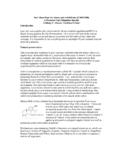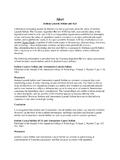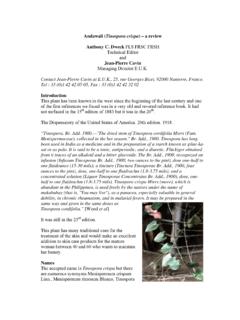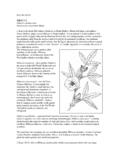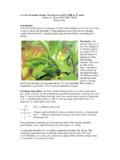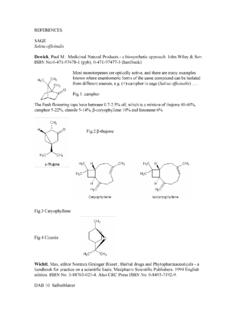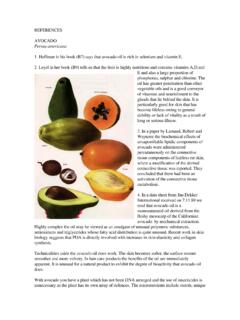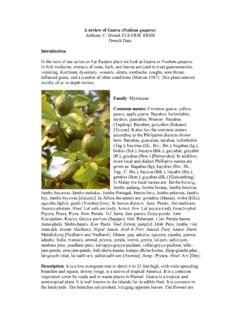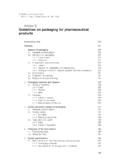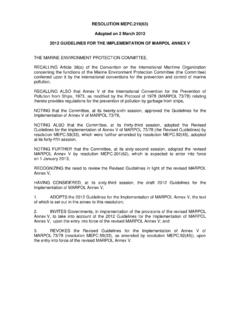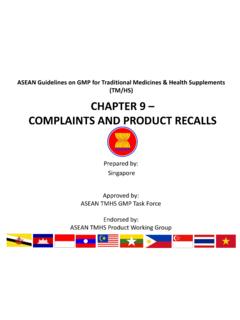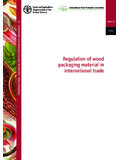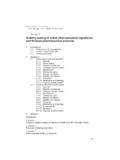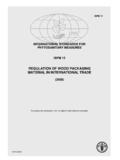Transcription of Colipa - cosmetic product labelling - Anthony Dweck
1 Colipa guidelines ON cosmetic product labelling , 2011 Page 1 of 32 COMPLIANCE WITH REGULATION 1223/2009 ON cosmetic PRODUCTS Colipa guidelines ON cosmetic product labelling 15 December 2011 Page 2 of 32 Table of contents: I. Introduction 3 II. Quick guide for cosmetic product labelling 4 Which products? 4 When? 4 What? 4 Where? 5 How? 5 Particular cases 6 III. Specific guidance for each labelling requirement 9 Name and address of responsible person, country of origin 9 Nominal content 9 Date of minimum durability 10 Particular precautions / warnings 11 Batch number 12 product function 12 List of ingredients 13 IV.
2 Related horizontal labelling requirements 18 Aerosols 18 Flammable products 19 Nominal quantities 19 Packaging and packaging waste 19 V. List of references 20 VI. Annexes Language requirements in the various Member States for the labelling of precautions to be observed in the use of cosmetic products 22 Colipa -IFRA guidelines on the exchange of information between fragrance suppliers and cosmetics manufacturers, revised 2011 23 INCI names for 26 substances added to Annex III of the Cosmetics Directive 33 This guidance document was prepared by Colipa to assist its member associations and companies, as well as other interested persons, and is for information purposes only.
3 Although every effort was made to ensure that the information and guidance contained in this document are correct, to the best knowledge of the authors, Colipa does not accept responsibility for any actions taken on the basis of this information, nor does it accept any liability for any omissions or errors this publication may contain. Only the original legal text of the cosmetic Products Regulation (Regulation N 1223/2009) and/or rulings issued by the EU Courts have legally binding powers. Page 3 of 32 I. INTRODUCTION Regulation 1223/2009 of the European Parliament and the Council of 30 November 2009 on cosmetic products (the Cosmetics Regulation or the Regulation ) was published in the Official Journal of the European Union on 22 December 2009 (OJEU, L 342, p.)
4 59). The Regulation will replace Directive 76/768/EC (the Cosmetics Directive or the Directive ), which has been governing the composition, labelling and packaging of finished cosmetic products in the European Union since 1976. This replacement will be fully effective on 11 July 2013 when all provisions of the Regulation become enforceable. The Regulation is a recast of the Cosmetics Directive and does not introduce fundamental changes to the regulatory framework of the Directive. Being in the form of a Regulation and no longer a Directive, it applies to all Member States and does not need to be transposed into national legislation. Any cosmetic products placed on the EU market before 11 July 2013 may comply either with the Cosmetics Directive or with the Cosmetics Regulation.
5 After that date, products must comply with the Regulation. The information that must be printed on cosmetic product labels (containers and packaging) is regulated under Article 19 of the Cosmetics Regulation. New requirements introduced by the Regulation are the symbol for date of minimum durability (Annex VII, point 3) and the indication of ingredients present in the form of nanomaterials. The Regulation also acknowledges that the period after opening is not required when the concept of durability after opening is not relevant: for single-use products, products presented in containers that do not allow contact between the product and the external environment and products for which there is no risk of deterioration that could lead to non-conformity of the product with the safety requirements of the Regulation.
6 These guidelines are intended to provide information and guidance on the labelling requirements of the Regulation. They consist of three main parts: a quick guide for cosmetic product labelling in the EU, specific guidance on the individual requirements and references to labelling requirements in other, horizontal regulations that apply to cosmetic products. Page 4 of 32 II. QUICK GUIDE FOR cosmetic product labelling IN THE EUROPEAN UNION Which products? The Cosmetics Regulation applies to cosmetic products. Article a defines cosmetic products as any substance or mixture intended to be placed in contact with the external parts of the human body (epidermis, hair system, nails, lips and external genital organs) or with the teeth and the mucous membranes of the oral cavity with a view exclusively or mainly to cleaning them, perfuming them, changing their appearance, protecting them, keeping them in good condition or correcting body odours.
7 This definition applies to all cosmetic products, be they sold in shops, through vending machines, by mail order, via the internet, applied by professionals, or made available in hotels, spas etc. When? The labelling requirements of the Regulation become mandatory as of 11 July 2013 (Article 40). All products made available on the market on or after 11 July 2013 (including those that are already on shelves) have to comply with the new Cosmetics Regulation. However, companies can voluntarily comply with the labelling requirements of the Regulation from 11 January 2010, which is the date when the Regulation entered into force (Article 39). As the Regulation only introduces few new labelling elements, and as these are not relevant for the vast majority of cosmetic products, most products which were labelled in line with the Cosmetics Directive will already comply with the labelling provisions of the Regulation.
8 What? The following table contains an overview of the compulsory labelling requirements of the Regulation. Please see Chapter III for more detailed information on each of these requirements. Cosmetics Regulation Article Requirement Art (a) Name or registered name and the address of the responsible person Art (a) Country of origin for cosmetic products imported into the EU Art (b) Nominal content at the time of packaging by weight or by volume. Exceptions: for pre-packaged items, number of items if weight or volume are not relevant; packaging containing less than five grams or five millilitres, free samples and single-application packs Art (c) Date of minimum durability preceded by the symbol or the words: best used before the end of.
9 Indication of the date of minimum durability is not mandatory Page 5 of 32 for products with a minimum durability of more than 30 months. For such products except where the concept of durability after opening is not relevant an indication of the period of time after opening has to be indicated for which the product is safe and can be used without any harm to the consumer. This information shall be indicated by the symbol followed by the period (in months and/or years, but usually in months as x M ); Art (d) Information regarding possible precautions to be observed in use. Note especially the compulsory information listed in Annexes III to VI. Art (e) Batch number or reference to identify the final cosmetic product .
10 When products are too small, such information need appear only on the packaging. Art (f) Function of the cosmetic product , unless it is clear from its presentation Art (g) List of ingredients (INCI). May be indicated on the packaging only. Must be preceded by the term ingredients . Please note that for cosmetic products packaged in aerosol dispensers there are additional requirements specified by Directive 75/324/EEC (for further details, please see section ). Where? The Regulation refers to two types of packaging for cosmetic products: the container (also known as primary package or inner package) is the packaging designed to come into direct contact with the product ; The packaging (also known as secondary package or outer package) is the packaging designed to contain one or more containers, including protective materials, if any.
